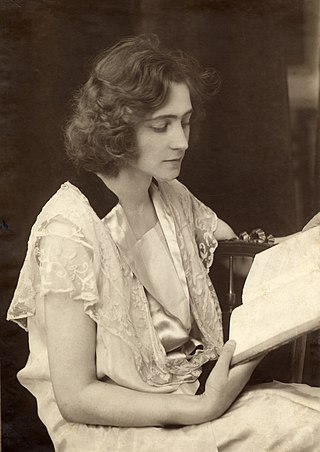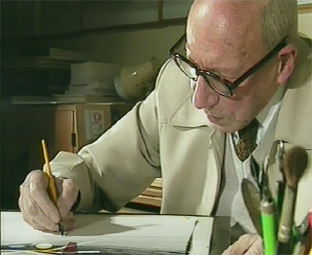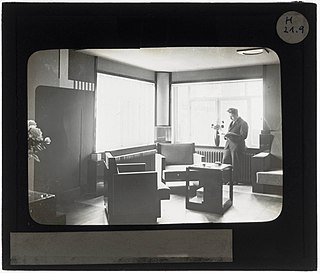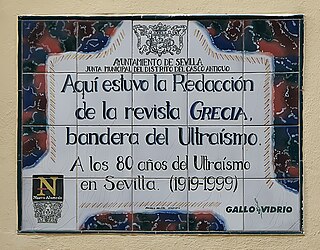
The Manifesto of Futurism is a manifesto written by the Italian poet Filippo Tommaso Marinetti and published in 1909. Marinetti expresses an artistic philosophy called Futurism that was a rejection of the past and a celebration of speed, machinery, violence, youth and industry. It also advocated for the modernization and cultural rejuvenation of Italy.

Cubo-Futurism or Kubo-Futurizm was an art movement, developed within Russian Futurism, that arose in early 20th century Russian Empire, defined by its amalgamation of the artistic elements found in Italian Futurism and French Analytical Cubism. Cubo-Futurism was the main school of painting and sculpture practiced by the Russian Futurists. In 1913, the term "Cubo-Futurism" first came to describe works from members of the poetry group "Hylaeans", as they moved away from poetic Symbolism towards Futurism and zaum, the experimental "visual and sound poetry of Kruchenykh and Khlebninkov". Later in the same year the concept and style of "Cubo-Futurism" became synonymous with the works of artists within Ukrainian and Russian post-revolutionary avant-garde circles as they interrogated non-representational art through the fragmentation and displacement of traditional forms, lines, viewpoints, colours, and textures within their pieces. The impact of Cubo-Futurism was then felt within performance art societies, with Cubo-Futurist painters and poets collaborating on theatre, cinema, and ballet pieces that aimed to break theatre conventions through the use of nonsensical zaum poetry, emphasis on improvisation, and the encouragement of audience participation.

Lou Albert-Lasard was an Expressionist painter.

Alice Bailly was a Swiss avant-garde painter, known for her interpretations on cubism, fauvism, futurism, her wool paintings, and her participation in the Dada movement. In 1906, Bailly had settled in Paris where she befriended Juan Gris, Francis Picabia, and Marie Laurencin, avant-garde modernist painters who influenced her works and her later life.
Ça ira was the Belgian monthly magazine that featured avant-garde art, literature and politics.

Alice Nahon was a Belgian poet from Antwerp.

Fernand Berckelaers, pseudonym Michel Seuphor, was a Belgian painter.

Valentine de Saint-Point was a French writer, poet, painter, playwright, art critic, choreographer, lecturer and journalist. She is primarily known for being the first woman to have written a futurist manifesto. Additionally, she was also active in Parisian salons and the associated literary and artistic movements of the Belle Epoque. Her writings and performances of La Métachorie demonstrated her theory of "a total fusion of the arts." Performed veiled, it is an exploration of the body's relationship to nature and geometric archetypes that govern physical form and movement. Finding a similar universality in Islamic art, she converted to Islam and moved to Alexandria where she also became involved in Middle Eastern politics, writing prolifically as an advocate for Egyptian and Syrian independence from French rule. She died at the age of 78. Her Muslim name was Ruhiyya Nur al-Din and she is buried next to the Imam al-Shafii.
Punct was a Romanian art and literary magazine published from 1924 to 1925.

Jozef Peeters (1895–1960) was a Belgian painter, engraver and graphic artist.

Fillìa was the name adopted by Luigi Colombo, an Italian artist associated with the second generation of Futurism. Aside from painting, his works included interior design, architecture, furniture and decorative objects.

Lacerba was an Italian literary journal based in Florence closely associated with the Futurist movement. It published many Futurist manifestos by Filippo Marinetti, Antonio Sant'Elia, and others.
Nuori Voima is a Finnish literary and cultural magazine which has been published since 1908. It is headquartered in Helsinki, Finland. Both the magazine and its parent organization, Nuoren Voiman Liitto, are among the well-respected institutions in Finland.

Hubrecht (Huib) Hoste was a Belgian architect, designer and urban planner. He is considered the pioneer of modern architecture in Belgium.
La Gaceta Literaria was a bimonthly avant-garde literary, arts and science magazine which appeared in Madrid, Spain, between 1927 and 1932. It is known for its leading contributors and editorial board members.
Prometeo was a monthly avant-garde magazine which existed between 1908 and 1912 in Madrid, Spain. The magazine was established by the avant-garde writer Javier Gómez de la Serna. Its subtitle was revista social y literaria.
Noi: Rivista d’arte futurista was an avant-garde magazine which adopted a futurist stance. It was published in Rome between 1917 and 1925. Its subtitle was Raccolta internazionale d’arte d’avanguardia.
Zwrotnica was an avant-garde magazine which was one of the significant publications in Poland. It appeared in Kraków in two periods: first between 1922 and 1923, and then between 1926 and 1927. Despite its short run, it is the first Polish avant-garde magazine that had an international audience.

Grecia was a literary magazine which was published from 1918 to 1920 in Spain. Its subtitle was Revista Decenal de Literatura. Later it was redesigned as Revista de literatura. It was a traditionalist as reflected in its title and modernist publication in the early years, but later adopted an avant-garde approach and became the flagship of the ultraísmo.












